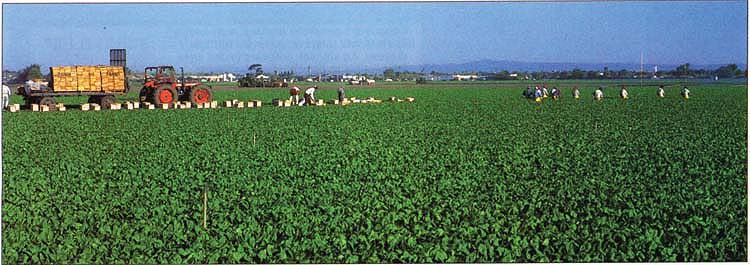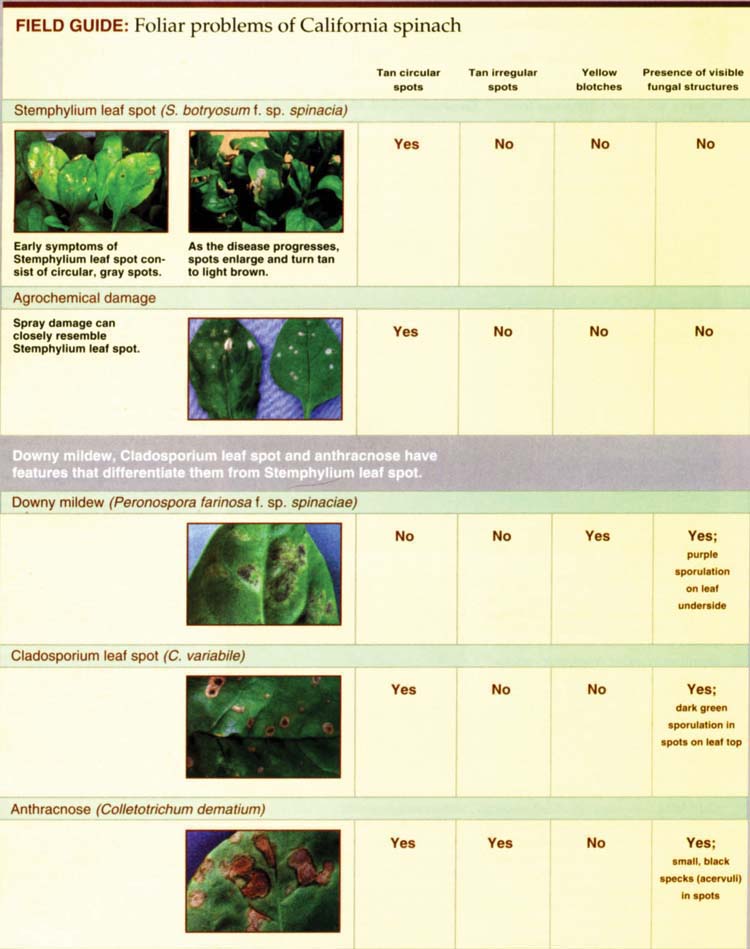All Issues
Host-specific strain of Stemphylium causes leaf spot disease of California spinach
Publication Information
California Agriculture 55(5):31-34. https://doi.org/10.3733/ca.v055n05p31
Published September 01, 2001
PDF | Citation | Permissions
Abstract
The California spinach industry has grown dramatically over the past few decades; it now supplies well over 100,000 tons of various high-quality products to consumers. But a new foliar disease. Stemphylium leaf spot, can reduce spinach quality. After identifying this disease, we determined that the pathogen may also be a new, distinct strain of the fungus that is specific to spinach. Inoculation experiments demonstrated that numerous spinach lines are susceptible, including new downy mildew-resistant cultivars. Diagnosing this disease can be difficult because its symptoms often resemble damage from agrochemicals. Growers and pest control advisors should become familiar with the symptoms of the various foliar spinach diseases that occur in California because consumers of this crop tolerate only a small level of leaf spots and defects.
Full text
Spinach has grown into a $104 million industry in California. A new host-specific strain of Stemphylium leaf spot causes symptoms that can be difficult to distinguish from spray drift damage.
Spinach is one of the major leafy vegetables grown in California (LeStrange et al. 1996). Over the past 40 years the crop has increased dramatically in acreage, tonnage and value. By 1999, more than 23,700 acres of spinach were grown, with a gross value of approximately $104 million (CASS 2000). About half of the state's spinach crop is produced in Monterey County's Salinas Valley. The moderate climate in this coastal region allows farmers to grow spinach year-round.
Spinach production in the Salinas Valley involves exceptionally high seeding rates because the climate is favorable and the cultivars allow it. Spinach products include processed frozen, standard fresh market and fresh market “baby leaf” (harvested at the four- to five-leaf stage); these are planted at 0.3 to 0.6, 1.0 to 1.5 and 1.5 to 3.0 million viable seeds per acre, respectively. Produce wholesalers, retailers and consumers demand extremely high quality spinach from California and tolerate only a small level of foliar diseases. These include downy mildew, caused by Peronospora farinosa f. sp. spinaciae; Cladosporium leaf spot, caused by Cladosporium variabile; and anthracnose, caused by Colletotrichum dematium (Correll et al. 1994; Koike and Correll 1993; Koike et al. 1992). Foliar diseases do not affect the nutritional value or taste of the spinach, only its appearance.
A new problem
Starting in 1997 and continuing into 2000, growers and pest control advisors observed foliar symptoms that did not match those of known spinach diseases on commercial spinach in the Salinas and Santa Maria (Santa Barbara County) valleys. The damage to crops was limited.
On both immature and mature leaves, initial symptoms consisted of leaf spots that were one-eighth to one-quarter inch in diameter, circular to oval in shape, and gray-green in color. As the disease progressed, leaf spots expanded, remained circular to oval in shape, and turned tan in color. Older leaf spots coalesced, dried up and became papery in texture. Leaf spots could enlarge and result in the death of significant portions of the leaves. On fully expanded and young leaves, symptoms closely resembled the tan, circular spots caused by pesticide and fertilizer spray damage.
Consumers generally demand high-quality spinach and tolerate low levels of foliar disease. All spinach cultivars tested were susceptible to Stemphylium leaf spot.
In addition, the spots of this new problem lacked the visual signs of fungal growth, which contributed to the assumption that such spots were associated with chemical damage. Because several fields with such symptoms had not been sprayed with any agricultural chemicals - or affected by spray drift - we conducted an investigation into the cause of the spotting.
We analyzed symptomatic leaves by sterilizing their surfaces and placing small pieces of the leaf spots onto various agar media used for isolating microorganisms. When we examined them several days later, we did not recover bacteria from the leaf sections. However, we consistently isolated a fungus from numerous leaf spots. All recovered isolates were identified as Stemphylium botryosum because the spores of each isolate had the appropriate shape and size for this species as described by previous researchers (Wiltshire 1938).
Proving ability to cause disease
To find out if this Stemphylium fungus was causing the leaf spot symptoms on spinach, we prepared spore suspensions of several isolates and sprayed them with a hand-held mister until the suspension ran off the leaves, onto sets of spinach (‘Bolero’) plants at the four- to six-true-leaf stage. We incubated the inoculated plants in a dew chamber for 48 hours and then in a greenhouse. We sprayed control plants with distilled water and handled them in the same way. If symptoms developed on inoculated plants, we conducted isolations to recover pathogens. We conducted these inoculation and isolation experiments three times.
The spinach sprayed with isolate suspensions developed circular, gray-green leaf spots after 1 week and were similar to those observed on diseased plants in the field. By the second week these spots turned the characteristic tan color. We consistently isolated Stemphylium fungi from the leaf spots and found them to be the same as the original isolates. None of the control plants treated with water developed symptoms. Results from the three experiments were consistent, confirming that S. botryosum is the cause of this new leaf spot problem.
After confirming the pathogenicity of our isolates, we evaluated the responses of various spinach cultivars to the pathogen by spraying spore suspensions onto 20 flat leaf, semisavoy and savoy spinach cultivars; all of these were susceptible (Koike et al. 2001). After these experiments, California growers began planting different spinach cultivars that are resistant to the new races of downy mildew occurring in the state.
Once the growers changed cultivars, we tested additional cultivars by spraying S. botryosum onto two of these new cultivars as well as onto spinach lines used in downy mildew research. A water control was included for each cultivar. After 2 weeks, we evaluated plants for susceptibility to the pathogen. Isolations were conducted on representative leaf spots to confirm the presence of the pathogen. We then repeated the experiment.
When we sprayed them with isolates of S. botryosum, all spinach cultivars developed leaf spots within 2 weeks, while the water controls did not develop any spots. Symptoms were similar to those observed in commercial fields, and S. botryosum was reisolated from representative leaf spots. None of the control plants treated with water developed symptoms. Results from the two experiments were similar. This work indicates that newer cultivars resistant to new downy mildew races (‘Rushmore’, resistant to races 1, 3-5; ‘Lion’, resistant to 1-6) are as susceptible as other cultivars having different resistance profiles: ‘Viroflay’ (no resistance), ‘Resistoflay’ (1, 2), ‘Califlay’ (1, 3) and ‘Whitney’ (1-4).
Host specificity of pathogen
In our initial experiments, we found that 16 different non-spinach plants, known to be susceptible to an S. botryosum pathogen, failed to become infected when inoculated with the spinach isolates (Koike et al. 2001). This raised the possibility that S. botryosum from spinach could be host-specific to spinach. To investigate this further, we tested whether spinach could be infected by isolates of S. botryosum from other plants. For this experiment we obtained various S. botryosum isolates from plants growing in Monterey County: one from alfalfa, four from lettuce and one growing on dead leaves in a cauliflower field. We prepared spore suspensions of these isolates and sprayed them onto spinach. A spinach isolate was used as a positive control. We also inoculated lettuce plants with the lettuce isolates of S. botryosum. We handled and incubated plants as described previously and repeated the experiment.
When we inoculated the spinach test plants with the positive control isolate obtained from spinach, they developed the expected leaf spot disease. Lettuce plants likewise developed leaf spots when we sprayed them with the lettuce isolates. However, when we inoculated spinach with alfalfa, lettuce or dead cauliflower leaf isolates, no symptoms or disease developed. Results from both experiments were similar.
Spinach-specific pathogen
Prior to the new research presented here, we documented that a new spinach disease, Stemphylium leaf spot caused by Stemphylium botryosum, was present in the state (Koike et al. 2001). While S. botryosum is often considered a weak pathogen or secondary decay organism on other crops, our various studies demonstrated that the spinach isolates are primary pathogens and can cause significant damage. All spinach cultivars tested were susceptible to the pathogen, including recently introduced cultivars (‘Lion’, ‘Rushmore’) that are resistant to the new races of downy mildew presently found in California.
Our most recent studies demonstrate that isolates of S. botryosum from spinach appear to infect only spinach, and other S. botryosum isolates from other sources do not infect spinach. These findings indicate that the spinach pathogen may be a distinct sub-population. Therefore, we suggest that the spinach isolates be designated as S. botryosum f. sp. spinacia. Additional research is needed to further document this host-speciticity. Previous forma specialis designations have been made for other S. botryosum pathogens, such as S. botryosum f. sp. lactucae for isolates infecting lettuce (Padhi and Snyder 1954; Raid 1997) and S. botryosum f. sp. lycopersici for isolates infecting tomato (Rotem and Bashi 1977; Rotem et al. 1966).
Information on host specificity can be important for disease management decisions made by growers. If this leaf spot disease develops in spinach fields planted adjacent to lettuce, growers need not be concerned about this fungus spreading to lettuce. Likewise, growers need not worry that the S. botryosum pathogen from lettuce is the source of this new spinach disease.
Diagnostic challenge
Stemphylium leaf spot symptoms can be confused with early symptoms of Cladosporium leaf spot or damage caused by chemicals. Prior to 1997, the UC Cooperative Extension Diagnostic Laboratory in Salinas received samples of spinach with symptoms resembling those of Stemphylium leaf spot; however, because of the close resemblance to chemical burn, the samples were not further analyzed. It is possible, therefore, that Stemphylium leaf spot occurred in California prior to 1997 but was misdiagnosed as chemical damage. Field personnel and pest control advisors should now exercise caution when diagnosing apparent spray burn on spinach, as this new disease closely resembles such damage. The symptoms of Stemphylium leaf spot, which include light tan, round leaf spots that lack visible fungal structures, should distinguish this new disease from downy mildew, Cladosporium leaf spot and anthracnose ( see p. 33 ).
While downy mildew and Cladosporium leaf spot are typically the most destructive foliar diseases of spinach, the addition of Stemphylium leaf spot adds yet another challenge for California growers to overcome in producing large volumes of high-quality, defect-free spinach.







